modern abstrakt konst
Modern abstrakt konst representerar en revolutionär tillvägsgångssätt till konstnärlig uttryck som dykt upp på 1900-talets tidiga år och fortsätter att utvecklas i nutida tider. Denna konstform slippar ifrån traditionella representativa begränsningar och fokuserar på att kommunicera känslor, koncept och upplevelser genom icke-objektiva visuella element såsom färg, form, linje och gestalt. Modern abstrakt konst fungerar både som ett sätt att uttrycka sig personligt och som ett kraftfullt verktyg för inredning, företagsutrymmen och offentliga installationer. Den använder olika tekniker inklusive digital manipulation, blandad media och traditionella målmetoder för att skapa verk som utmanar betraktarnas perception och stimulerar intellektuell engagemang. Teknologisk integration i modern abstrakt konst har utvidgat dess möjligheter genom att inkorporera interaktiva element, digitala projektioner och AI-genererade komponenter. Dessa verk har flera tillämpningar, från att förbättra arkitektoniska utrymmen och arbetsmiljöer till att underlätta terapeutiska praktiker i hälso- och sjukvården. Versenligheten hos modern abstrakt konst gör det möjligt att anpassa sig till olika skalor och sammanhang, vilket gör det lika påverkande i små hemliggöranden eller stora offentliga platser. Denna konstform fortsätter att driva gränser genom att inkorporera nya teknologier och svara på samtida sociala och kulturella rörelser, vilket bevarar dess relevans i dagens snabbt utvecklade visuella kultur.


